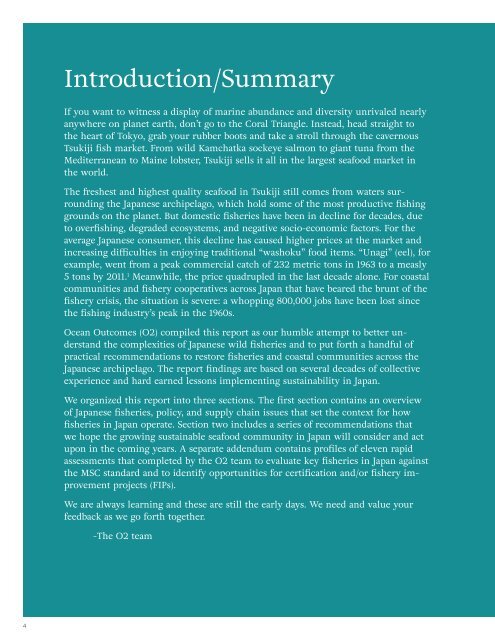OPPORTUNITIES
1WSDsgH
1WSDsgH
You also want an ePaper? Increase the reach of your titles
YUMPU automatically turns print PDFs into web optimized ePapers that Google loves.
Introduction/Summary<br />
If you want to witness a display of marine abundance and diversity unrivaled nearly<br />
anywhere on planet earth, don’t go to the Coral Triangle. Instead, head straight to<br />
the heart of Tokyo, grab your rubber boots and take a stroll through the cavernous<br />
Tsukiji fish market. From wild Kamchatka sockeye salmon to giant tuna from the<br />
Mediterranean to Maine lobster, Tsukiji sells it all in the largest seafood market in<br />
the world.<br />
The freshest and highest quality seafood in Tsukiji still comes from waters surrounding<br />
the Japanese archipelago, which hold some of the most productive fishing<br />
grounds on the planet. But domestic fisheries have been in decline for decades, due<br />
to overfishing, degraded ecosystems, and negative socio-economic factors. For the<br />
average Japanese consumer, this decline has caused higher prices at the market and<br />
increasing difficulties in enjoying traditional “washoku” food items. “Unagi” (eel), for<br />
example, went from a peak commercial catch of 232 metric tons in 1963 to a measly<br />
5 tons by 2011. 1 Meanwhile, the price quadrupled in the last decade alone. For coastal<br />
communities and fishery cooperatives across Japan that have beared the brunt of the<br />
fishery crisis, the situation is severe: a whopping 800,000 jobs have been lost since<br />
the fishing industry’s peak in the 1960s.<br />
Ocean Outcomes (O2) compiled this report as our humble attempt to better understand<br />
the complexities of Japanese wild fisheries and to put forth a handful of<br />
practical recommendations to restore fisheries and coastal communities across the<br />
Japanese archipelago. The report findings are based on several decades of collective<br />
experience and hard earned lessons implementing sustainability in Japan.<br />
We organized this report into three sections. The first section contains an overview<br />
of Japanese fisheries, policy, and supply chain issues that set the context for how<br />
fisheries in Japan operate. Section two includes a series of recommendations that<br />
we hope the growing sustainable seafood community in Japan will consider and act<br />
upon in the coming years. A separate addendum contains profiles of eleven rapid<br />
assessments that completed by the O2 team to evaluate key fisheries in Japan against<br />
the MSC standard and to identify opportunities for certification and/or fishery improvement<br />
projects (FIPs).<br />
We are always learning and these are still the early days. We need and value your<br />
feedback as we go forth together.<br />
-The O2 team<br />
4



